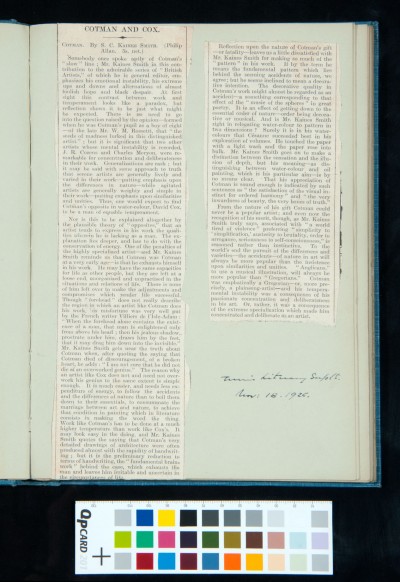Cotmania. Vol. I. 1926-7
Archive: SDK Sydney Decimus Kitson Archive
Reference Number: SDK/1/2/1/1
Page: 8 recto
-
Description
Cotman and Cox book review
Newscutting - a review of Kaines Smith's book on John Sell Cotman in the Times Literary Supplement.
Date: 18-Nov-26
-
Transcription
Cotman. By S.C. Kaines Smith. (Philip Allan. 5s net.) Someone once spoke aptly of Cotman's "slow" line, Mr. Kaines Smith in this contribution to the admirable series of "British Artists," of which he is general editor, emphasizes his emotional instability, his extreme ups and downs and alternations of almost foolish hope and black despair. At first sight this contrast between work and temperament looks like a paradox, but reflection shows it is just what might be expected. There is no need to go into the question raised by the the opinion - formed when he was Cotman's pupil as a boy of eight - of the late Mr. W. M. Rosetti, that "the seeds of madness lurked in this distinguished artist" ; but it is significant that two other artists whose mental instability is recorded, J. R. Cozens and Charles Meryon, were remarkable for concentration and deliberateness in their work. Generalizations are rash; but it may be said with some approach to truth that serene artists are generally lively and varied in their work - putting emphasis upon similarities and unities. Thus, one would expect to find Cotman's opposite in water-colour, David Cox, to be a man of equal temperament. Nor is this to be explained altogether by the plausible theory of "opposites," that an artist tends to express in his work the qualities wherein he is lacking as a man. The explanation lies deeper , and has to do with the conservation of energy. One of the penalties of the the highly specialized artist - and Mr Kaines-Smith reminds us that Cotman was Cotman at a very early age - is that he exhausts himself in his work. He may have the same capacities for life as other people, but they are left at a loose end, unorganiized and unpractised in the situations and relations of life. There is non of him left over to make the adjustments and compromises which render life successful. Though "forehead" does not really describe the region in which an artist like Cotman does his work, his misfortune was very well put by the French writer Villiers de l'Isle-Adam: "When the forehead alone contains the existence of a man, that man is enlightened only from above his head ; then his jealous shadow,. prostrate under him, draws him by the feet, that it may drag him down into the invisible." Mr. Kaines Smith gets near the truth about Cotman when, after quoting the saying that Cotman died of discouragement,. of a broken heart, he adds: "I am not sure that he did not die of an overworked genius." The reason why an artist like Cox does not and need not overwork his genius to the same extent is simple enough. It is much easier, and needs less expenditure of energy, to follow the accidents and differences of nature than to boil them down to their essentials, to consummate the marriage between art and nature, to achieve that condition in painting which in literature consists in making the word the thing. Work like Cotman's has to be done at a much higher temperature than work like Cox's. It may look easy in the doing, and Mr. Kaines Smith quotes the saying that Cotman's very detailed drawing of architecture, were almost produced with the rapidity of handwriting ; but it is the preliminary reduction to terms of handwriting, the "fundamental brainwork" behind the case, which exhausts the man and leaves him irritable and uncertain in the circumstances of life. Reflection upon the nature of Cotman's gift - or fatality- leaves us a little dissatisfied with Mr. Kaines Smith for making so much of the "pattern" in his work.If by the term he means the fundamental pattern that lies behind the seeming accidents of nature, we agree; but he seems to be inclined to mean a decorative intention. The decorative quality in Cotman's work might almost be regarded as an accident, a something corresponding to that effect of the "music of the spheres" in great poetry. It is an effect of getting down to the essential order of nature - order being decorative or musical. And is Mr. Kaines Smith right in relegating watercolour to pattern in two dimensions? Surely it is in his watercolours that Cezanne succeeded best in his exploration of volumes. He touched the paper with a light wash and the water rose into bulk. Mr Kaines Smith goes on to make a distinction between the sensation and the illusion of depth, but his meaning - as distinguishing between watercolour and oil painting, which is his particular aim - is by no means clear. That his appreciation of Cotman is sound enough is indicated by such sentences as "the satisfaction of the visual instinct for ordered harmony" and " the very inwardness of beauty, the very bones of truth." From the nature of his gift Cotman could never be a popular artist; and even now the recognition of his merit, though, as Mr Kaines Smith truly says, associated with " a world tired of violence" preferring "simplicity to 'simplification,' austerity to brutality, order to arrogance, seriousness to self-consciousness," is reasoned rather than instinctive. To the world's end the pursuit of differences and varieties - the accidents - of nature in art will always be more popular than the insistence upon similarities and unities. "Anglicans", to use a musical illustration, will always be more popular than "Gregorians". Cotman was emphatically a "Gregorian" -or more precisely a plain-song artist - and his temperamental instability was a consequence of his passionate concentration and deliberateness in his art. Or rather it was a consequence of the extreme specialization which made him concentrated and deliberate as an artist.
Times Literary Sup[p]l[emen]t
Nov: 18.1926.
